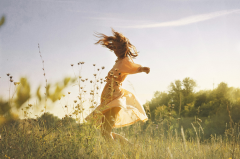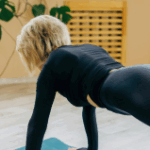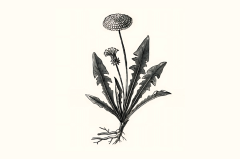The emotional toll of fertility can feel like a roller-coaster ride — cycles of hoping, waiting and not knowing. It’s easy to get caught up in the details and worry about missing the one crucial step that could make all the difference. The process of trying to conceive a baby can become a source of despair, rather than hope. Drawing on the wisdom of Chinese medicine, it’s possible to see the bigger picture and navigate this time with more joy.
Fertility is far more than the ability to conceive a child. At its core, it is the ability to create. It’s the life spark that can transform and regenerate.
We see it everywhere in the natural world: the rhythm of the seasons, the unfurling of leaves, the flow of the rivers. Nature moves in harmony — silent, powerful and balanced. Everything in the universe is infused with this creative pulse (including you), bringing something into existence that wasn’t there before.
In Chinese medicine, this pulse is known as qi, the vital energy that flows through all living things. Rooted in the philosophy of Taoism, Chinese medicine teaches that everything follows the Tao — “the Way”.
Taoism invites us to observe nature and its effortless unfolding. The tides do not force their movement. Trees do not strive to grow. They simply respond with grace to the elements around them. Taoism teaches us to embrace patience, spontaneity and balance.
Think of bamboo: strong yet flexible. When the wind blows, bamboo bends rather than breaks. It adapts. It yields. And it survives.
What is creative conception?
If you are trying to conceive, aren’t you essentially trying to create something from nothing?
Yes, there is an egg and a sperm, but an extraordinary sequence of perfectly timed events must unfold to form an embryo.
It makes sense that, during this sacred time, immersing yourself in other creative practices could help tune you into the same energetic rhythm that causes flowers to bloom, rain to fall and life to take root within you.
When you are in a state of artistic flow — whether painting, journaling, dancing or dreaming — the body and mind merge into a space of pure presence and possibility.
This creative state mirrors the ebb and flow of a woman’s cycle: open, expansive and generative. Anything that nourishes your soul and activates your imagination supports this process. It doesn’t have to be productive or even particularly artistic.
What matters is how it makes you feel. Does it connect you to your essence? To the energy of motherhood? To life itself?
How creativity can support conception
For many women, the fertility journey can be fraught with grief, frustration and longing.
Cultivating creativity can be an anchor during this time, offering both emotional relief and energetic alignment.
Managing stress: Creativity is a powerful stress reliever. Activities such as painting, knitting, journaling, gardening, music or movement calm the nervous system and invite flow. Reduced stress supports hormonal balance, reproductive health and emotional wellbeing.
Exploring options: A creative mindset is open and adaptive. It helps you navigate different fertility pathways — whether through lifestyle changes, cycle tracking or assisted reproductive technologies — with more ease and flexibility.
Building emotional resilience: Creativity helps reframe setbacks to find meaning and hope. Art, poetry, storytelling and symbolism can help you make sense of emotional ups and downs. A 2018 research study by Streeter and Deaver found that art can be effective in reducing depression symptoms in women experiencing infertility.
Deepening connection with your body: Creative practices based on mindful movement such as yoga, qi gong or dance can increase awareness of your body’s rhythms and signals — helpful for tuning into ovulation cycles and hormonal cues.
Processing complex emotions: Creative expression can be an outlet for grief, longing and reproductive trauma. Think of artist Frida Kahlo, whose iconic works vividly explore themes of fertility, loss and the emotional depth of not being able to conceive. She transformed her pain into art.
Nature to the rescue
As always, nature has the answers — if we pause to listen.
Recent research shows that women tend to be more creative during certain phases of their menstrual cycle. The menstrual cycle is not just a biological rhythm; it also influences mood, cognition and emotional expression.
During the follicular phase, the first half of the cycle leading up to ovulation, oestrogen levels rise. This hormonal increase is linked to enhanced cognitive flexibility and verbal fluency — two key components of creative thinking.
A study from SWPS University of Social Sciences and Humanities in Warsaw found that women generated more original, varied and perspective-altering ideas during their ovulatory phase.
The researchers suggest this surge in creativity may be evolutionary — part of an adaptive strategy for courtship and mate selection.
Dr Galasinska, co-author of the study, explains:
“Women evolved in a way that when the time to conceive occurs, they unconsciously start to behave differently. Sexual hormones are a kind of mood enhancer and a positive mood affects the flexibility of thinking. Also, women feel more courageous and powerful … to be creative, we have to take a risk a little bit, as creativity requires breaking through patterns and mental blocks.”
It all comes down to qi
In traditional Chinese medicine (TCM), qi is the life force that animates everything. Yin is the substance — blood, tissue, fluids, the nurturing and cooling element. Yang is the function — the heat, movement, drive, metabolism. Health (and fertility) requires balance among these forces.
Creative energy is seen as a reflection of your vitality and the flow of qi. When qi is stagnant or blocked, both fertility and creativity can become stifled. It can also lead to emotional imbalances like frustration, anger or sadness. In fertility, free-flowing qi is ess





